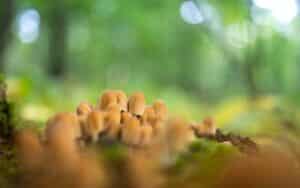What The Scientific Research on Psilocybin Can Tell Us About Its Potential for Mental Health Treatments
By Emilee Wright
Psilocybin is the active compound in Psilocybe cubensis, commonly referred to as ‘magic mushroom’. It is a hallucinogen with an extensive history of use for ceremonial and recreational purposes.
In 2000, a group of Johns Hopkins researchers were the first to obtain regulatory approval in the United States to resume research on psychedelics. In 1968, the United States Congress passed the Staggers-Dodd Bill, which amended the Food, Drug, and Cosmetic Act. This law criminalized the possession of psychedelic substances, which made it impossible for academic research on them to take place. Following this, all psychedelics were classified as Schedule I drugs under the Controlled Substance Act, classifying them as having no medical potential and a high risk of abuse (Ferenstein, 2022).
Over the following 20 years since research on psilocybin has been reinstated, many potential medicinal benefits of this fungus have been documented. The Center for Psychedelic and Consciousness Research at Johns Hopkins University is the leading research team on psilocybin in the United States (Ercolano, 2022). Most of the recent studies on psilocybin have been conducted by these researchers, particularly for the treatment of addiction, depression, and anxiety. Research is also confirming the potential for psilocybin-induced spiritual experiences that increase one’s meaning and satisfaction in life.
The studies are conducted using the established guidelines for human hallucinogen research. Psychedelics are not considered substances of dependence, and users are at low risk of having physiological complications. But the use of psychedelics comes with unique psychological risks. The biggest risk is distress during the trip, which can cause dangerous behavior that the researchers may be unable to control. Another risk that is less common is the experience of prolonged psychosis following the use of the psychedelic substance. For this reason, all participants of the study are required to be evaluated for psychotic disorders. Only those who were cleared, and have no family history of the disorders are allowed to participate in the study. Before the substance is administered, the researchers establish rapport with the participants in an effort to reduce anxiety while the trip is taking place. During the follow-up meeting, the participants are screened for Hallucinogen Persistent Perception Disorder to evaluate how they adapt to the altered state of consciousness that the psychedelic elicits (Johnson, 2008).
In what is now considered a landmark study, researchers demonstrated that psilocybin has the ability to produce spiritual experiences during the trip. In the 2006 publication titled “Psilocybin Can Occasion Mystical Type Experiences Having Substantial and Sustained Personal Meaning and Spiritual Significance”, participants were given psilocybin in a comfortable and supportive environment. They expressed experiencing a range of perceptual and subjective changes during the experiment. At the 2-month follow-up evaluation, participants reported that the experience had significant personal and spiritual meaning and that it contributed to a lasting positive impact on their outlook on life (Griffiths, 2006). The findings of this study propelled community interest in furthering academic research.
The altered state of perception that psilocybin induces may have extensive clinical benefits for those suffering from depressive and anxious mental health disorders. One study conducted in 2016, evaluated the impact of psilocybin use on cancer patients with anxiety and depression due to their life-threatening diagnosis. This was a randomized, double-blind, and cross-over trial conducted on 51 cancer patients. They were given either a very low dose of 1-3mg, considered to be a placebo. Or were given a high dose of 22-30 mg of psilocybin. Participants, medical staff, and observers in their community were asked to rate the participant’s behaviors, moods, and attitudes throughout the study. At the 6-month follow-up, it was observed that the high dose of psilocybin decreased depression and anxiety by both the participant’s self-reporting and the reports of those who observed them. These changes in outlook, quality of life, and reduced anxiety toward death were sustained by 80% of the participants (Griffiths, 2016).
Along with the emotional health benefits of psilocybin, the fungus may be a treatment for substance addiction. In 2014, a study was published in the Journal of Psychopharmacology testing the effect of psilocybin on nicotine-addicted smokers. The study had a small sample size of 15 individuals who were habitual smokers with a mean of: 6 previous attempts to quit smoking over their lifetime; smoking 19 cigarettes per day; and 31 years of continuous usage of cigarettes. They were given moderate (20mg) to high (30mg) doses of psilocybin within a 15-week treatment. At the 6-month follow-up of the study, 12 out of the 15 participants had successfully quit smoking. This was measured by self-report and by testing to determine who has consumed nicotine over the past 7-days. The success rate of this study was 80%, which is substantially higher than other behavioral or pharmacological treatments that report a success rate of less than 35% (Johnson, 2014).
Enthusiastic about the results of their studies, Johns Hopkins researchers proposed to reclassify the mushroom from a Schedule I drug to a Schedule IV. A Schedule I is a substance with no known medical potential, whereas a Schedule IV is a substance that is strictly controlled but prescription access for medicinal uses is available (Hedin, 2018). Despite this, as of 2022, psilocybin is still classified as a Schedule I drug.
Due to these findings and the potential that psilocybin has for medicinal uses, the first federal grant for psychedelic treatment research was awarded in 2021 by the National Institutes of Health (Barnett, 2021). This is the first grant for the purpose of psychedelic research awarded by the United States government in over 50 years. Thus far, there is no FDA-approved use of this substance for pharmaceutical purposes. More research is necessary for the mushrooms and their derivatives to be confidently used in clinical settings. But it is very likely that in the future, a treatment option for substance addiction and major depression will be to have a psychedelic trip at your doctor’s office.
Works Cited
Barnett, B. “United States National Institutes of Health Grant Funding for Psychedelic-Assisted Therapy Clinical Trials from 2006-2020.” The International Journal on Drug Policy, U.S. National Library of Medicine, 2021, https://pubmed.ncbi.nlm.nih.gov/34624734/.
Ferenstein, Greg. “Psychedelics and Mental Health Care – What Policymakers Need to Know.” Niskanen Center, 17 May 2022, https://www.niskanencenter.org/psychedelics-and-mental-health-care-what-policymakers-need-to-know/#:~:text=’%20In%201968%2C%20the%20Staggers%2D,under%20the%20Controlled%20Substances%20Act.
Ercolano, Alexa. “Johns Hopkins Center for Psychedelic and Consciousness Research.” Johns Hopkins Center for Psychedelic and Consciousness Research, 25 Feb. 2022, https://www.hopkinsmedicine.org/psychiatry/research/psychedelics-research.html.
Griffiths, R.R., and W.A. Richards. “Psilocybin Can Occasion Mystical-Type Experiences Having Substantial and Sustained Personal Meaning and Spiritual Significance.” Psychopharmacology, U.S. National Library of Medicine, Aug. 2006, https://pubmed.ncbi.nlm.nih.gov/16826400/.
Griffiths, Roland R, et al. “Psilocybin Produces Substantial and Sustained Decreases in Depression and Anxiety in Patients with Life-Threatening Cancer: A Randomized Double-Blind Trial.” Journal of Psychopharmacology (Oxford, England), SAGE Publications, Dec. 2016, https://www.ncbi.nlm.nih.gov/pmc/articles/PMC5367557/.
Hedin, Marin. “Hopkins Researchers Recommend Reclassifying Psilocybin, the Drug in ‘Magic’ Mushrooms, from Schedule I to Schedule IV.” The Hub, 26 Sept. 2018, https://hub.jhu.edu/2018/09/26/psilocybin-scheduling-magic-mushrooms/.
Johnson, M.W., et al. “Human Hallucinogen Research: Guidelines for Safety.” Journal of Psychopharmacology , 2008, https://files.csp.org/Psilocybin/HopkinsHallucinogenSafety2008.pdf.
Johnson, Matthew W, et al. “Pilot Study of the 5-HT2AR Agonist Psilocybin in the Treatment of Tobacco Addiction.” Journal of Psychopharmacology (Oxford, England), U.S. National Library of Medicine, Nov. 2014, https://www.ncbi.nlm.nih.gov/pmc/articles/PMC4286320/.
